NCERT Exemplar Class 9 Science Solutions Chapter 1 Matter In Our Surroundings
Multiple Choice Questions
Question 1.
Which one of the following sets of phenomena would increase on raising the temperature?
(a) Diffusion, evaporation, compression of gases
(b) Evaporation, compression of gases, solubility
(c) Evaporation, diffusion, expansion of gases
(d) Evaporation, solubility, diffusion, compression of gases
Solution:
(c) Rate of evaporation, diffusion and expansion of gases increase with increase in temperature.
Question 2.
Seema visited a Natural Gas Compressing Unit and found that the gas can be liquefied under specific conditions of temperature and pressure. While sharing her experience with friends she got confused. Help her to identify the correct set of conditions.
(a) Low temperature, low pressure
(b) High temperature, low pressure
(c) Low temperature, high pressure
(d) High temperature, high pressure
Solution:
(c) Gases can be compressed under low temperature and high pressure. Under these conditions the particles of gases come closer and liquefy.
Question 3.
The property to flow is unique to fluids. Which one of the following statements is correct?
(a) Only gases behave like fluids.
(b) Gases and solids behave like fluids.
(c) Gases and liquids behave like fluids.
(d) Only liquids are fluids.
Solution:
(c) Gases and liquids flow due to less intermolecular force in the molecules. Gases and liquids take the shape of the container in which they are put.
Question 4.
During summer, water kept in an earthen pot becomes cool because of the phenomenon of
(a) diffusion
(b) transpiration
(c) osmosis
(d) evaporation.
Solution:
(d) Earthen pot has small pores through which water keeps evaporating and evaporation causes cooling.
Question 5.
A few substances are arranged in the increasing order of ‘forces of attraction’ between their particles. Which one of the following represents a correct arrangement?
(a) Water, air, wind
(b) Air, sugar, oil
(c) Oxygen, water, sugar
(d) Salt, juice, air
Solution:
(c) Forces of attraction between the particles increase in the order of gases < liquids < solids hence, the correct arrangement is oxygen, water, sugar.
Question 6.
On converting 25°C, 38°C and 66°C to Kelvin scale, the correct sequence of temperature will be
(a) 298 K, 311 K and 339 K
(b) 298 K, 300 K and 338 K
(c) 273 K, 278 K and 543 K
(d) 298 K, 310 K and 338 K
Solution:
(a) K =25 °C + 273
Hence 25°C = 273 + 25 = 298 K
38°C = 273 + 38 = 311 K
66°C = 273 + 66 = 339 K
Question 7.
Choose the correct statement of the following.
(a) Conversion of solid into vapours without passing through the liquid state is called vapourisation.
(b) Conversion of vapours into solid without passing through the liquid state is called sublimation.
(c) Conversion of vapours into solid without passing through the liquid state is called freezing.
(d) Conversion of solid into liquid is called sublimation. ’
Solution:
(b) Conversion of vapours into solid without passing through the liquid state is called sublimation.
Question 8.
The boiling points of diethyl ether, acetone and n-butyl alcohol are 35°C, 56°C and 118°C respectively. Which one of the following correctly represents their boiling points in Kelvin scale?
(a) 306 K, 329 K, 391 K
(b) 308 K, 329 K, 392 K
(c) 308 K, 329 K, 391 K
(d) 329 K, 392 K, 308 K
Solution:
(c): 35°C = 273 + 35 = 308 K
56°C = 273 + 56 = 329 K
118°C = 273 + 118 = 391 K
Question 9.
Which condition out of the following will increase the evaporation of water?
(a) Increase in temperature of water
(b) Decrease in temperature of water
(c) Less exposed surface area of water
(d) Adding common salt to water
Solution:
(a): Rate of evaporation increases with increase in temperature of water.
Question 10.
ln which of the following conditions, the distance between the molecules of hydrogen gas would increase?
(i) Increasingpressureonhydrogencontained in a closed container.
(ii) Some hydrogen gas leaking out of the container.
(iii) Increasing the volume of the container of hydrogen gas.
(iv) Adding more hydrogen gas to the container without increasing the volume of the container.
(a) (i) and (iii)
(b) (i) and (iv)
(c) (ii) and (iii)
(d) (ii)and(iv)
Solution:
(c) (ii) If some hydrogen gas is leaked from the container the remaining gas will occupy the whole space and the distance between the molecules will increase.
(iii) If the volume of the container is increased, same number of molecules will occupy that space. Hence, the distance between the molecules will increase.
Short Answer Type Questions
Question 11.
A sample of water under s^tudy was found to boil at 102°C at normal temperature and pressure. Is the water pure? Will this water freeze at 0°C? Comment.
Solution:
The sample of water boils at a higher temperature which shows that water is not pure. Due to impurities present in it water boils at a higher temperature. This water will freeze below 0°C.
Question 12.
A student heats a beaker containing ice and water. He measures the temperature of the content of the beaker as a function of time.
Which of the following (Fig. 1.1) would correctly represent the result? Justify your choice.
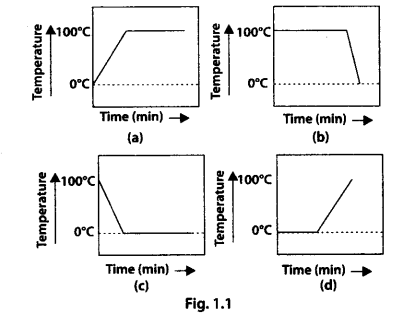
Solution:
(d) Since ice and water are in equilibrium, the temperature would be zero. When we heat the mixture, ‘energy supplied is utilised in melting the ice and the temperature does not change till the ice melts because of latent heat of fusion. On further heating the temperature of the water would increase. Therefore (d) is the correct option.
Question 13.
Fill in the blanks:
(a) Evaporation of a liquid at room temperature leads to a ______ effect.
(b) At room temperature the forces of attraction between the particles of solid substances are ______ than those which exist in the gaseous state.
(c) The arrangement of particles is less ordered in the ______ state. However, there is no order in the state.
(d) ______ is the change of gaseous state directly to solid state without going through the ______ state.
(e) The phenomenon of change of a liquid into the gaseous state at any temperature below its boiling point is called ______.
Solution:
(a) Cooling
(b) Stronger
(c) Liquid, gaseous
(d) Sublimation, liquid
(e) Evaporation
Question 14.
Match the physical quantities given in column A to their SI units given in column B.
| Column (A) | Column (B) | ||
| (a) | Pressure | (i) | cubic metre |
| (b) | Temperature | (ii) | kilogram |
| (c) | Density | (Hi) | pascal |
| (d) | Mass | (iv) | kelvin |
| (e) | Volume | (v) | kilogram per cubic metre |
Solution:
(a) (iii)
(b) (iv)
(c) (v)
(d) (ii)
(e) (i)
Question 15.
The non SI and SI units of some physical quantities are given in column A and column B respectively. Match the units belonging to the same physical quantity.
| Column (A) | Column (B) | ||
| (a) | Degree Celsius | (i) | kilogram |
| (b) | Centimetre | (ii) | pascal |
| (c) | Gram per centimetre cube | (iii) | metre |
| (d) | Bar | (iv) | kelvin |
| (e) | Milligram | (v) | kilogram per rpetrecube |
Solution:
(a) (iv)
(b) (iii)
(c) (v)
(d) (ii)
(e) (i)
Question 16.
‘Osmosis is a special kind of diffusion’. Comment.
Solution:
In diffusion, the particles move from higher concentration to lower concentration without separation by a semipermeable membrane. In osmosis, the particles move from lower concentration to higher concentration (solvent to solution) when the two solutions are separated by a semipermeable membrane. Hence, osmosis is a special kind of diffusion involving movement of particles.
Question 17.
Classify the following into osmosis/diffusion:
(a) Swelling up of a raisin 9n keeping in water.
(b) Spreading of virus on sneezing.
(c) Earthworm dying on coming in contact with common salt.
(d) Shrinking of grapes kept in thick sugar syrup.
(e) Preserving pickles in salt.
(f) Spreading of smell of cake being baked throughout the house
(g) Aquatic animals using oxygen dissolved in water during respiration.
Solution:
(a) Osmosis
(b) Diffusion
(c) Osmosis
(d) Osmosis
(e) Osmosis
(f) Diffusion
(g) Diffusion
Question 18.
Water as ice has a cooling effect, whereas water as steam may cause severe burns. Explain these observations.
Solution:
Water in the form of ice has low energy since water freezes at a lower temperature. When ice comes in contact with body it draws heat from the body and gives cooling effect. In case of steam, the water molecules have high energy. The high energy of steam is transformed as heat and may cause severe burns.
Question 19.
Alka was making tea in a kettle. Suddenly she felt intense heat from the puff of steam gushing out of the spout of the kettle. She wondered whether the temperature of the steam was higher than that of the water boiling in the kettle. Comment.
Solution:
The temperature of both boiling water and steam is 100°C but steam has more energy because of latent heat of vaporisation. Hence, steam is hotter than boiling water.
Question 20.
A glass tumbler containing hot water is kept in the freezer compartment of a refrigerator (temperature < 0°C). If you could measure the temperature of the content of the tumbler, which of the following graphs (Fig. 1.2) would correctly represent the change in its temperature as a function of time.
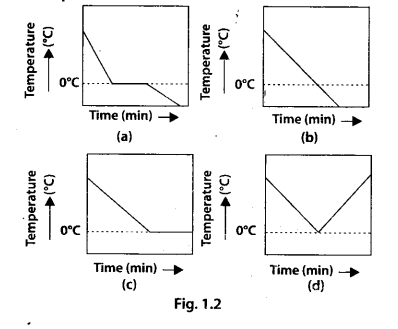
Solution:
(a) The hot water in the glass tumbler kept in freezer will first become cold and the temperature will drop till 0°C. At 0°C, water loses heat equal to latent heat of fusion till entire water freezes to form ice at 0°C. During this change of state from liquid to solid, the temperature remains constant.
On still further cooling, the temperature of ice slowly falls with time. Therefore, the correct option is (a).
temp.
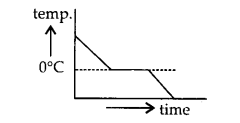
Question 21.
Look at Fig. 1.3 and suggest in which of the vessels A, B, C or D the rate of evaporation will be highest? Explain.
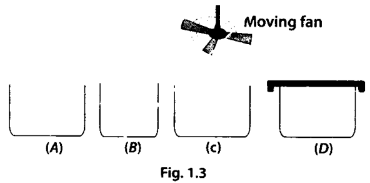
Solution:
The rate of evaporation depends on the surface area of the container. More the surface area, more is the evaporation. It also depends on the speed of the wind. If speed of the wind is more, more number of particles will evaporate from the surface. Hence, the figure (C) in which both these factors, surface area and moving fan are there, the rate of evaporation will be maximum.
Question 22.
(a) Conversion of solid to vapour is called sublimation. Name the term used to denote the conversion of vapour to solid.
(b) Conversion of solid state to liquid state is called fusion; what is meant by latent heat of fusion?
Solution:
(a) Sublimation
(b) Latent heat of fusion is the amount of heat required to change 1 kg solid into liquid at atmospheric pressure at its melting point.
Long Answer Type Questions
Question 23.
You are provided with a mixture of naphthalene and ammonium chloride by your teacher. Suggest an activity to separate them with well labelled diagram.
Solution:
Mixture of naphthalene and ammonium chloride can be separated as follows :
Step-1: Put the mixture in a beaker and add water to it. Stir with a glass rod. Ammonium chloride being soluble in water gets dissolved leaving behind the insoluble naphthalene.
Step-2: Filter the solution. Naphthalene remains on the filter paper while ammonium chloride is obtained as filtrate.
Step-3: Evaporate the filtrate to get back ammonium chloride.
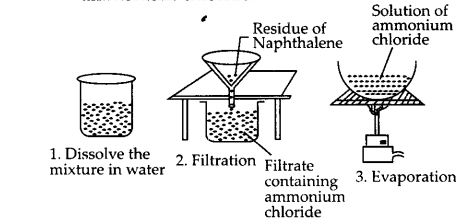
Question 24.
lt is a hot summer day, Priyanshi and Ali are wearing cotton and nylon clothes respectively. Who do you think would be more comfortable and why?
Priyanshi is wearing cotton clothes which are more comfortable in summers because cotton absorbs the sweat which causes cooling on evaporation. Ali is wearing nylon clothes which do not absorb sweat. Hence, Ali will be uncomfortable.
Question 25.
You want to wear your favourite shirt to a party, but the problem is that it is still wet after a wash. What steps would you take to dry it faster?
Solution:
The process of drying the shirt can be made faster in the following ways :
(a) Spread the shirt to increase the surface area which will increase rate of evaporation.
(b) Put it in the sun to increase the temperature to increase the rate of evaporation.
(c) Keep it under the fan to increase the wind speed which increases the rate of evaporation.
Question 26.
Comment on the following statements:
(a) Evaporation produces cooling.
(b) Rate of evaporation of an aqueous solution decreases with increase in humidity.
(c) Sponge though compressible is a solid.
Solution:
(a) Evaporation is a surface phenomenon. The particles from the surface of the liquid take energy from the surroundings and change into vapours which results in the decrease in energy of the surroundings. Hence, cooling effect is produced during evaporation.
(b) The amount of water present in the air is known as humidity. If the water vapour in air is already present in large amount, it is not able to take up more water through evaporation. Hence, the rate of evaporation of water will decrease. On a dry day, the air absorbs water more readily hence, the rate of evaporation is high on a dry day.
(c) A sponge is a solid but it has minute pores in which air is trapped. These pores make the sponge a soft material. When sponge is pressed, the air present in the pores comes out and the sponge is compressed.
Question 27.
Why does the temperature of a substance remain constant during its melting point or boiling point?
Solution:
When a substance melts, it absorbs heat for the conversion of solid state into liquid state. As we continue heating, the heat supplied is used up in converting the solid state into liquid state by overcoming the forces of attraction between the particles and there is no change in temperature till the whole solid is converted into liquid. This heat absorbed by the solid which does not resitlt in increase in temperature, is called latent heat of fusion. When a liquid is heated, it starts converting into vapours.
Further heat given to the liquid is used in changing the state and there is no increase in the temperature till the liquid starts boiling. This heat is known as latent heat of vaporisation. Hence, the temperature of a substance remains constant at its melting point or boiling point untill all the substance melts or boils.
FAQ’s
Q. Explain the various state of matter properties discussed in Chapter 1 of NCERT Exemplar Solutions for Class 9 Science.
Ans: Six criteria determine the distinct features of a state of matter:
- Shape
- Quantity
- Fluidity vs. Rigidity
- Intermolecular force
- Intermolecular space
- Compressibility
The NCERT Exemplar Solutions for Class 9 Science Chapter 1 curated by the specialists at Infinity Learn briefly explains these ideas. The solutions are written in simple language to make studying easy for the pupils.
For more visit NCERT Exemplar Solutions for Class 11 Physics Chapter 9 – Mechanical Properties of Solids

